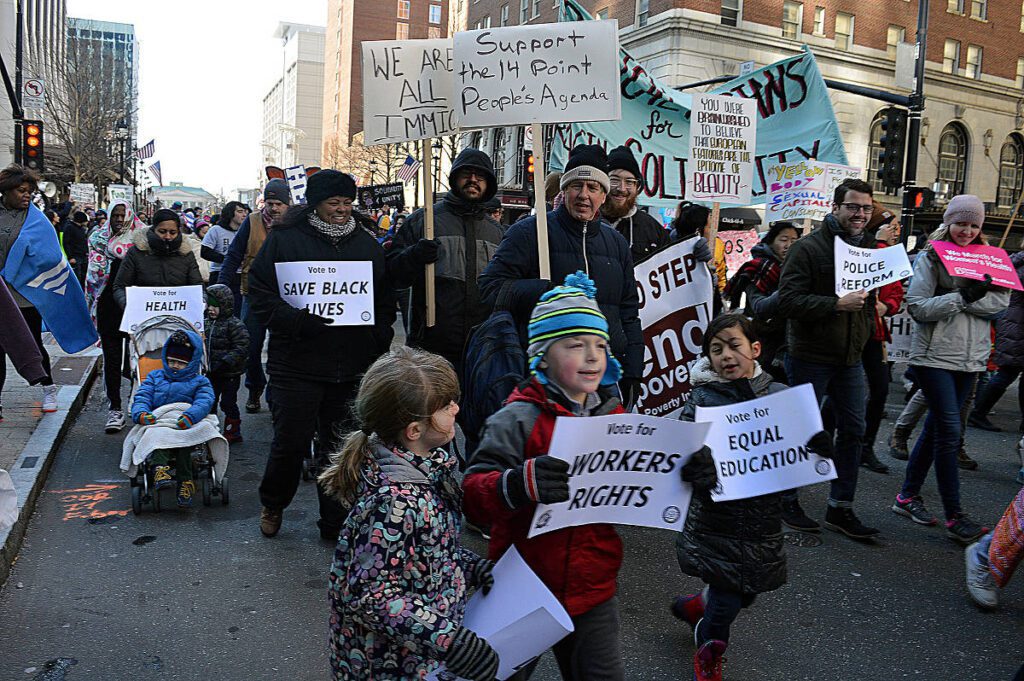
By Sasha Hammad
The opinions expressed here do not necessarily represent those of the Kairos Center or its staff.
This February, I felt as though I were being let in on a big secret before everyone else. I had the opportunity to participate in the Moral March on Raleigh with the Kairos Center and Union Theological Seminary students.
I had heard of the Moral Mondays movement in 2014. What I heard is that unprecedented numbers of everyday people in the South were taking to the streets of North Carolina to demand justice, and that folks were engaging in nonviolent direct action and risking arrest. My experiences with arrests have been either getting caught in arbitrary police repression or blocking traffic under an agreement with the police so as to escalate the drama of a campaign. Hearing about the civil disobedience at Moral Mondays sounded less like today’s permitted protests and more like the civil rights movement.
We arrived in Raleigh just in time for the mass meeting the night before. Even on the ride down, my partner and I asked ourselves, “Why don’t we have mass meetings the night before our actions?” We heard from leaders of at last four different faiths. We clapped, on our feet, to Gospel music. A rabbi urged us to shift from complaining to taking action. The meeting ended with a multiracial group of organizers lingering to embrace one another. The church had to ask us to leave -very nicely! – so that they could close up. I left excited for the next day.
At the rally the next morning, the first signs of the march were signs that I would be surprised to see at any of the labor-centered marches I usually go to in New York: Vegans for Peace, Planned Parenthood, Veterans for Peace. I was pleased to see strong contingents from the United Food and Commercial Workers and from SEIU’s adjunct faculty organizing campaign. The speakers at the opening rally were not politicians, nor union presidents, but folks who are on the front lines of fighting against structural oppression. The cold eventually seeped from the asphalt through my boots up to my feet, so I went to the nearby McDonald’s to get warm. The place was packed with people who came for the march, and this is where I realized that this march was not just different in style, but in substance, from most I had been to.
McDonald’s was full of young Black men and women wearing NAACP hats and holding signs urging people to “vote for quality education” and to “vote for affordable healthcare.” Latino families with kids in tow shared pancakes before the march started. Everyone was chatting, laughing, introducing newcomers to their friends. I didn’t notice any professional organizers minding these groups. This mobilization appeared to be the product of deep organizing in communities of color.
We saw the rally begin to morph into a march and went outside to join. A large group of health professionals dressed in white medical coats passed by. Immigrants and young people held up red Farm Labor Organizing Committee flags. Marchers danced to a percussion band that reminded me of the Rude Mechanical Orchestra, minus the brass section and the green sequins. College students carried handmade Black Lives Matter signs. We flooded downtown Raleigh. In the sea of people there was a feeling of openness, maybe even joy, at coming together to march in the cold.
At the closing rally, I was amazed at how many people stayed for the program. Again, there was just one elected official at the podium, a Republican mayor who was advocating for the expansion of Medicaid. The other speakers shared the stress of the threat of deportation, the difficulty of getting out of medical debt, the hopes of young people for the future. I, who usually find rallies boring and a display of institutional players jockeying for power, was moved and wanted to hear more. Many nodded as Reverend Barber said, “It’s cold out here but we’re on fire for justice.” People cheered as the Reverend proclaimed, “Your time is over! It’s our Selma, it’s our vote, it’s our time.”
The rally was very well-organized. I just wish the organizers hadn’t waited until after Reverend Barber spoke – and most marchers finally dispersed – to collect voting pledge cards, and that their appeal to make donations to cover the cost of the event hadn’t been accessible only to people with smartphones. It was so cold, my phone screen didn’t respond to the touch of my fingertips.
For some of us, the day ended at a small reception. A multiracial, intergenerational group, including a father and son, reflected on the day and all the preparations that had gone into it. Although we were at the Holiday Inn, it felt more as if we were at a family reunion in someone’s living room. I think this is the product not only of a mobilizing project in North Carolina that dates back to 2006, but the groundwork for long haul organizing for solutions to deeply and widely felt issues.
How often do we see people come together across color lines? How often do people take action under a large umbrella for justice, instead of staying within issue-based silos? Why has it taken so long for the secret to get out? We are losing by not being connected to the Forward Together movement.
We have a lot more to learn about the power being built in North Carolina. Since national media outlets are not interested in giving this movement its due, it’s up to us to share transformative moments with one another, most importantly with our friends and family that aren’t active for social justice.
Let’s remember these words from February 13 when the going gets tough: “Until the walls of oppression come down, we will not stop. We will win!”